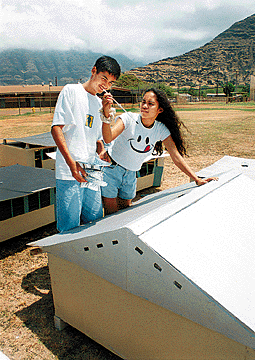
Students Justin Gomban and Lasha Salbosa check the temperature inside a model classroom at Waianae High.Photo by Ken Sakamoto, Star-Bulletin

Students Justin Gomban and Lasha Salbosa check the temperature inside a model classroom at Waianae High.Photo by Ken Sakamoto, Star-Bulletin
 "Project Portable" is a program initiated by the Star-Bulletin so that science students can conduct a physics experiment in a real-world scenario; in this case, coming up with ways of cooling the way-hot portable classrooms they occupy. The kids are conducting the experiment themselves, on their own time, and are learning about the process of science in a way that will help their fellow students.
"Project Portable" is a program initiated by the Star-Bulletin so that science students can conduct a physics experiment in a real-world scenario; in this case, coming up with ways of cooling the way-hot portable classrooms they occupy. The kids are conducting the experiment themselves, on their own time, and are learning about the process of science in a way that will help their fellow students.
They've built large-scale models of the portables, detailed down to window louvers and stilts so that airflow is similar. One model mirrors the state's version exactly; this is what is called the "control" in an experiment. Eight other models try out - singly or in multiple ways - various cooling strategies. As it turns out, all eight are cooler.
"We're trying to find which solution works best, or which combination of solutions works best," said Jennifer Kelleher, 17. "Light-colored roofs, insulation, ventilation - these all work to some extent."
In the process, the physics of convection, conduction and radiation - the major factors in the built environment - are becoming clearer to the kids, and hopefully for the rest of us.
One of the surprises, once they actually studied the portables close-up, was "how cheaply they were made," said Douglas Kamen, 17.
"They (the education department engineers) obviously didn't realize that these would be long-term classrooms," said Kelleher. "These days, I'm looking at all sorts of buildings and wondering if they were designed efficiently."
"One of the interesting things they're learning is that they had looked down on the original design, but are discovering that the designers had limitations imposed, too," said teacher Naidah Gamurot said of the students. "Welcome to the world of budget restrictions where just because you have a good idea, it doesn't mean it'll be used."
"The cool thing is analyzing things and using trial and error in solving problems," said Simi Leo, 17. "Looking at possibilities and figuring out ourselves what is best, instead of being told there is one right answer.
"We don't get too many hands-on projects in school. I'd like to do more. It's more fun, and easier to learn in some ways."
How about the home front? By now, these kids know more about energy-efficient home-cooling than most of their parents. How do their parents handle the heat?
"Fans!" they all said, more or less together.
Fans consume electricity, are mechanical and therefore require maintenance, and are the education department's current solution to portable cooling. The Waianae kids tested this model as well, and discovered that while it did cool the miniature classroom, it seems to be the LEAST efficient method.
Not all the learning process, however, is strictly scientific.
"One of the hardest things was learning to work together on a team effort," said Leo.
"Oh yeah, it's really hard working together, because all of us have different ideas," said Charisma Quitog, 18.
"It's been a real team effort, and what's surprising is that the team members have really used peer pressure to get the other kids to perform," said Gamurot. "I was surprised to hear these normally polite, shy kids chew each other out!
"And more - they've even covered for each other if one team falls behind. It's nice to see them look out for each other in order to help the whole project. In the grown-up world that's called professional courtesy."
Kelleher thought they'd get more class time. "But it's been more like independent study!"
"Yeah, but it's more ... idealistic than school work," said Kaman. "We might actually make a difference."
"It feels good that someone is trusting us, us kids, to experiment to find a solution," said Kelleher.
In June, the Star-Bulletin will publish their solution - The Waianae Solution - for cooling portable classrooms.
The education department has not granted permission for the kids to apply this knowledge to a real portable classroom, where temperatures this last week were well into the 90s. It looks like it'll be a long, hot summer school.